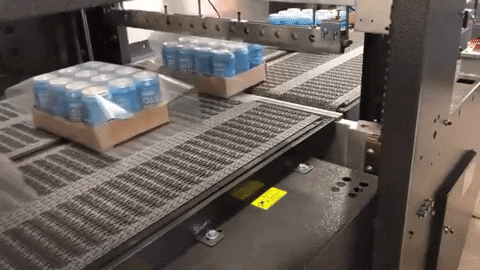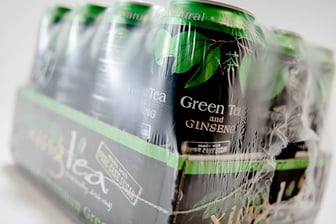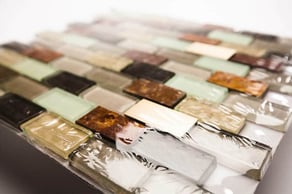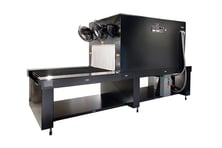
The Difference Between Shrink Bundling and Shrink Wrapping
Shrink bundling and shrink-wrapping sound similar, but there are key differences between the two. Follow along as we compare shrink bundling vs. shrink wrapping.
What is Shrink Bundling?
 Shrink bundling is commonly used more for function than appearance. Usually wrapped in heavier gauge polyethylene film, products can be sealed in a loose unsupported package or sealed in trays or cases. This type of sleeve wrapping is often seen on multi-pack beverage products such as water bottles, trayed products, multi-pack consumer goods, cases that need extra security, and other larger products bundled in a group. Once the products are sleeved, they move down the conveyor to a bundling tunnel where the film shrinks, creating tight and secured products.
Shrink bundling is commonly used more for function than appearance. Usually wrapped in heavier gauge polyethylene film, products can be sealed in a loose unsupported package or sealed in trays or cases. This type of sleeve wrapping is often seen on multi-pack beverage products such as water bottles, trayed products, multi-pack consumer goods, cases that need extra security, and other larger products bundled in a group. Once the products are sleeved, they move down the conveyor to a bundling tunnel where the film shrinks, creating tight and secured products.
Bundled products are typically sealed with open ends on both sides. These open ends look like a bulls-eye, which is why they are often referred to as a bulls-eye enclosure. Often times, the bulls-eye opening is used as a handle to transport the product.
What is Shrink Wrapping?
 Due to shrink wrapping’s cleaner overall finish, L-sealers are typically used when the product’s shelf appearance is critical. To meet the needs of the application, most sealers utilize a wide variety of films including polyolefin, polyethylene, or PVC. Shrink wrapping is great to seal an individual or a small number of products in a multi-pack. Like bundling, products are usually wrapped using a tray or case if there are more than one product and then moved along the conveyor to a tunnel to be sealed.
Due to shrink wrapping’s cleaner overall finish, L-sealers are typically used when the product’s shelf appearance is critical. To meet the needs of the application, most sealers utilize a wide variety of films including polyolefin, polyethylene, or PVC. Shrink wrapping is great to seal an individual or a small number of products in a multi-pack. Like bundling, products are usually wrapped using a tray or case if there are more than one product and then moved along the conveyor to a tunnel to be sealed.
Shrink Bundling vs. Shrink Wrapping
So what are the major differences? As mentioned above, bundling often involves many products sealed together, such as water bottles, or as an outer secure layer used to protect a product. Bundling is appealing to companies in the beverage, food, or industrial products industries due to the extra support and product security that bundling provides. Eastey’s EB25A automatic bundler is an example of an option that is great for bundling and sealing a wide variety of films, including polyolefin, polyethylene, and PVC. The EB25A utilizes two rolls of single wound film mounted on the same side of the machine and an upper and lower power film unwind for ease of use.
Shrink wrapping is also great for individual or small multi-pack items. This machinery differs from bundling due to the lower gauge, or mil thickness of the film commonly used in shrink wrapping applications and the seal bar’s shape. L-sealers have L-bar shaped seal arms instead of a single seal bar like the EB25A bundler mentioned above. The L- bar’s shape fully encloses the film around the product being sealed. Eastey’s L-sealers systems are great for positive sealing a wide variety of films, including polyolefin, polyethylene, and PVC. These L-sealers are equipped with either hot knife or hot wire seal bars depending on the type of film being used and the preference of the user. L-bar sealers are are available as manual, semi-automatic, and fully automatic systems depending on throughput and product. Combination units are also available with integrated shrink tunnel for portability and easy use.
 Shrink tunnels and bundling tunnels also differ from one another. Shrink tunnels are designed for smaller and lighter products. The tunnel opening is much smaller than a bundling tunnel opening, but both provide a great finish to products. Eastey’s performance series shrink tunnels are designed with variable four-direction air flow, variable air velocity, and delayed cool down.
Shrink tunnels and bundling tunnels also differ from one another. Shrink tunnels are designed for smaller and lighter products. The tunnel opening is much smaller than a bundling tunnel opening, but both provide a great finish to products. Eastey’s performance series shrink tunnels are designed with variable four-direction air flow, variable air velocity, and delayed cool down.
 Bundling tunnels have a bigger tunnel opening and overall size when compared to shrink tunnels. The increased size is due to the larger heating banks in the tunnel, which are bigger than those provided in a shrink tunnel. This ensures a quality finish of polyethylene bundling film. Bundling tunnels also feature exterior cooling fans and an extended outfeed conveyor to allow for proper package cooling once the products exit the tunnel.
Bundling tunnels have a bigger tunnel opening and overall size when compared to shrink tunnels. The increased size is due to the larger heating banks in the tunnel, which are bigger than those provided in a shrink tunnel. This ensures a quality finish of polyethylene bundling film. Bundling tunnels also feature exterior cooling fans and an extended outfeed conveyor to allow for proper package cooling once the products exit the tunnel.
We hope this helps explain the differences between shrink bundling and shrink wrapping. Do you still have questions? Our team of experienced packaging professionals is here to answer your questions and get you on the right track for all of your shrink packaging needs.
*Content originally provided by Engage Technologies

